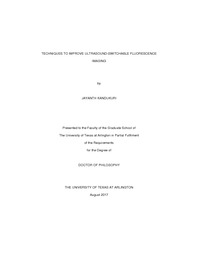
ATTENTION: The works hosted here are being migrated to a new repository that will consolidate resources, improve discoverability, and better show UTA's research impact on the global community. We will update authors as the migration progresses. Please see MavMatrix for more information.
Show simple item record
| dc.contributor.advisor | Yuan, Baohong | |
| dc.creator | Kandukuri, Jayanth | |
| dc.date.accessioned | 2017-10-02T14:17:45Z | |
| dc.date.available | 2017-10-02T14:17:45Z | |
| dc.date.created | 2017-08 | |
| dc.date.issued | 2017-08-14 | |
| dc.date.submitted | August 2017 | |
| dc.identifier.uri | http://hdl.handle.net/10106/26968 | |
| dc.description.abstract | Novel approaches to the improvement of ultrasound-switchable fluorescence (USF) imaging—a relatively new imaging modality that combines ultrasound and optical imaging techniques—have been proposed for early cancer detection. In USF, a high-intensity focused ultrasound (HIFU) beam is used to induce temperature rise within its acoustic focal region due to which a thermo-sensitive USF contrast agent undergoes a switch in its state by increasing the output of fluorescence photons. By using an increase in fluorescence, one can isolate and quantify the fluorescence properties within the ultrasonic focal area. Therefore, USF is able to provide fluorescence contrast while maintaining ultrasound resolution in tissue. The major challenge of the conventional USF technique is its low axial resolution and its sensitivity (i.e. its signal-to-noise ratio (SNR)). This work focuses on investigating and developing a novel USF system design that can improve the resolution and SNR of USF imaging for biological applications.
This work can be divided into two major parts: characterizing the performance of a high-intensity focused ultrasound transducer; and improving the axial resolution and sensitivity of the USF technique. Preliminary investigation was conducted by using an IR camera setup to detect temperature variation and thereby study the performance of the high-intensity focused ultrasound transducer to quantify different parameters of ultrasound-induced temperature focal size (UTFS). Investigations are conducted for the purpose of high-resolution imaging with an emphasis on HIFU-induced thermal focus size, short duration of HIFU-induced temperature increase (to avoid thermal diffusion or conduction), and control of HIFU-induced temperature increase within a few degrees Celsius. Next, the focus was shifted to improving the sensitivity of the ultrasound-switchable fluorescence-imaging technique. In this study, the USF signal is encoded with the modulation frequency of the ultrasound by modulating the induced temperature. Later, two approaches were adopted to modify the USF design to improve the resolution of the conventional USF imaging technique. The first approach aims to improve the axial resolution of conventional USF technique, which involves changing the USF system to adopt a dual-HIFU transducer arrangement (in which the transducers are 90 degree with respect to each other) for use as the heating source. The overlapped region of the two crossed foci (OR-TCF) of the dual-HIFU transducer module is expected to have small thermal size along both lateral and axial directions; thus, it could improve the axial resolution of the USF imaging technique. The second approach aims to demonstrate the improvement of resolution via a single-element HIFU transducer with a high frequency (15 MHz). The high frequency of the ultrasound transducer would have smaller acoustic lateral and axial size and should therefore have smaller thermal size. Thus, both approaches should be able to reduce the focal region of heating and thereby improve the resolution of the USF imaging.
Results show that the driving power and exposure time of the HIFU transducer significantly influence the ultrasound-induced temperature focal size (UTFS). Interestingly, a nonlinear acoustic effect was observed at certain variations of the ultrasound exposure power while satisfying the thermal confinement within UTFS. This has been shown to reduce UTFS beyond the acoustic diffraction limit, while the ultrasound-induced thermal energy, which is confined within the focal volume, can induce a desired peak-temperature increase of a few degrees. On other hand, after encoding the HIFU exposure and therefore the detected USF signal with a modulation frequency, the SNR (sensitivity) and full width at half maximum (FWHM) along the lateral direction of the USF image was calculated to be ~114 and ~0.95 mm for a micro-tube with an inner diameter of 0.31 mm (ID), respectively. In comparison, they are ~95 and ~1.1 mm when using a non-modulated conventional USF imaging technique. In the case of improving the axial resolution of USF imaging for a similar target size, the dual-HIFU USF design was able to achieve ~1.07 and ~1.5 mm along lateral (x) and axial (z) directions, respectively. Adopting the second approach of using single 15 MHz HIFU transducer for USF imaging, the axial resolution was calculated to be 0.67±0.02 mm and 1.71±0.24 mm along lateral (x) and axial (z) directions, respectively. Thus, high-resolution ultrasound-switchable fluorescence with good sensitivity can be designed for biomedical applications. | |
| dc.format.mimetype | application/pdf | |
| dc.language.iso | en_US | |
| dc.subject | Ultrasound imaging | |
| dc.subject | Ultrasound-switchable fluorescence imaging | |
| dc.subject | High-intensity focused ultrasound | |
| dc.subject | Multi-modality imaging | |
| dc.title | TECHNIQUES TO IMPROVE ULTRASOUND-SWITCHABLE FLUORESCENCE IMAGING | |
| dc.type | Thesis | |
| dc.degree.department | Bioengineering | |
| dc.degree.name | Doctor of Philosophy in Biomedical Engineering | |
| dc.date.updated | 2017-10-02T14:18:48Z | |
| thesis.degree.department | Bioengineering | |
| thesis.degree.grantor | The University of Texas at Arlington | |
| thesis.degree.level | Doctoral | |
| thesis.degree.name | Doctor of Philosophy in Biomedical Engineering | |
| dc.type.material | text | |
| dc.creator.orcid | 0000-0002-2425-5943 | |
Files in this item
- Name:
- KANDUKURI-DISSERTATION-2017.pdf
- Size:
- 3.346Mb
- Format:
- PDF
This item appears in the following Collection(s)
Show simple item record


